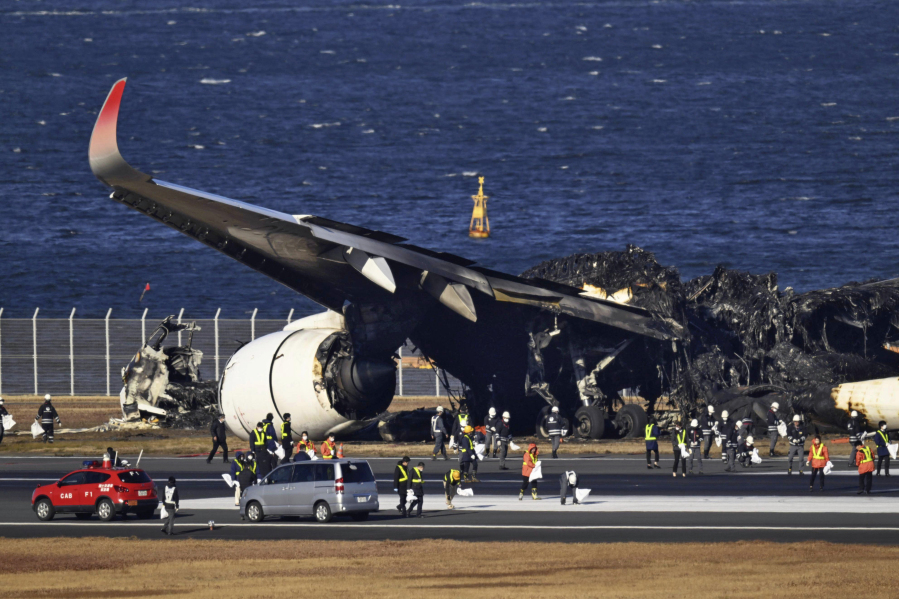Passengers on Japan Airlines Flight 516 were buckled up and ready to land at Tokyo’s Haneda Airport as their pilot made a final approach. “Cleared to land,” the pilot repeated after receiving an instruction from air traffic control to put the jet down on a specific runway.
About two minutes later, the Airbus A350 that had traveled from New Chitose Airport near Sapporo was engulfed in an orange fireball on the ground, spewing gray smoke from the side.
Manabu Kotake, a Sapporo resident visiting Tokyo, felt a strong bang and initially thought the airliner had made a rough touchdown. He looked out the window and observed flames, then noticed a burning smell. Seated near the engine, Kotake saw it falling apart.
“I panicked and thought I may not be able to survive,” he told Japanese news agency Jiji Press.
The A350 had collided with a much smaller coast guard plane that had received permission to approach the same runway but no takeoff clearance, according to a transcript of traffic control communications from the minutes before Tuesday’s crash. Experts say neither the JAL pilot nor air traffic controllers may have realized the Bombardier Dash-8 already had entered the runway by the time the airliner came in.
With investigators focused on how traffic control communicated with the two planes during the busy holiday travel period, the big question to have emerged so far is why the coast guard plane was there.
The pilot of the coast guard plane, which was leaving on a mission to deliver relief goods to earthquake survivors in central Japan, evacuated with serious burns, but five crew members were killed. All 379 passengers and crew members of Flight 516 survived after an evacuation that took 18 minutes.
After their safe escape down emergency chutes, some passengers have shared details of their harrowing ordeal with the media.
Television footage of a survivor’s video captured flight attendants repeatedly urging passengers to stay calm and to leave their belongings behind while making their way toward the closest of three frontward emergency exits that were usable. At first, passengers remained seated while waiting for attendants’ directions, some lowering their heads to avoid the smoke filling the cabin.
“Please let us out!” a child shouts. In another footage, a number of passengers, including a woman holding a baby to her chest, ducks down and cautiously edges toward an exit while covering their mouths and eyes with towels.
Yasuhito Imai, a Tokyo resident who was returning from Sapporo, his hometown, said children were crying and some people shouting, but many others kept calm and followed instructions to leave the burning plane on emergency chutes.
“We could evacuate without panicking,” he told Jiji, thanking other passengers and crew members.
Investigators from the Japan Transport Safety Board recovered flight data and voice recorders from the Bombardier on Wednesday as they examined what remained of the aircraft, the board said. The probe has focused on the communication between the traffic control and each pilot to figure out why the two planes ended up on the same runway.
Both the JAL and the coast guard pilots have said they had permission to use the runway where they collided. The coast guard has said officials were working to verify the coast guard pilot’s reported claim that he had received permission to take off.
JAL officials said the pilot of the A350 has reported not seeing the Bombardier after he received authorization to make a normal landing. JAL spokesperson Keiko Miyoshi said the airline’s position is that traffic control never instructed its pilot to abort the landing and perform a “go-around” instead.
Japan’s Transport Ministry released a transcript Wednesday of air traffic control communications of about 4 minutes and 25 seconds before the crash. It does not show the coast guard plane getting a clear green light to take off.
According to the transcript, the control tower gave the JAL plane permission to land and noted that there was a departing plane without identifying it. Two other departing flights were standing by around that time. The JAL pilot acknowledged its instructions by repeating “Cleared to land,” according to the transcript.
The coast guard plane said it was taxiing to the same runway, and traffic control instructed it to proceed to the stop line before the runway. The controller noted the coast guard gets the priority among departing flights, and the pilot repeated he was moving to the stop line. “No. 1, thank you,” the pilot says.
Some experts think the use of the term No. 1 might have reflected the coast guard pilot’s misunderstanding that he had permission to move on to the runway. Others suspect the coast guard members were in a rush to depart because of their supply delivery mission.
Two minutes later, there was a three-second pause, apparently indicating the time of the collision.



